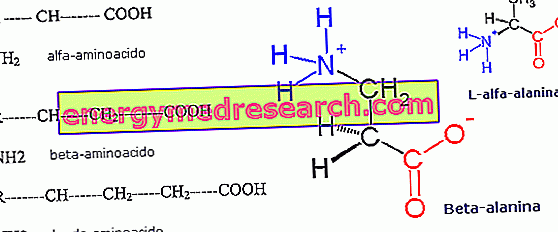Generality
Beta-Alanine is a non-essential amino acid, as it can be synthesized from Alanine through specific enzymatic pathways.
Unlike the vast majority of other amino acids, however, the amino group is not in an alpha position compared to the acid carbon (the one linked to the carboxyl group), but in the Beta position.
Unlike its alpha (α-alanine) counterpart, B-alanine lacks a chiral center (this means that there are no typical L and R forms of ordinary amino acids). Furthermore, it does not participate appreciably in protein synthesis.

The important antifatic and ergogenic role of Beta-Alanine in sports is due in part to its antioxidant activity, in part to its ability to regenerate muscle carnosine.
Indications
Why is Beta-Alanine used? What is it for?
Beta-Alanine is widely used in sports due to its different properties.
In fact, activity is used to use Beta-Alanine:
- anti-fatigue;
- ergogenic;
- improvements to aerobic performance;
- improvements to anaerobic performance;
- of muscle swab.
The aforementioned activities would be related both to the potential antioxidant role of Beta-Alanine and to the ability to regenerate Carnosine.
Beta-Alanine and Carnosine
Carnosine (Β-alanyl-L-histidine) is a dipetide present in high concentrations within human skeletal muscle.
By definition, a dipeptide is a molecule formed by the union of two single amino acids through a peptide bond; in the case of Carnosine these two amino acids are precisely the B-alanine and the L-histidine.
It has been clearly demonstrated that the limiting factor for Carnosine muscle synthesis is not Histidine, but Beta-alanine. This means that the levels of Carnosine in the body are limited by the availability of B-alanine for its synthesis.
Consequently, integration with Beta-Alanine would be effective in restoring, and in some cases enhancing, the Carnosine muscle pull.
Carnosine, in fact, is able to buffer lactic acid in the muscles, allowing it to withstand intense stress longer and favoring recovery after the race or training.
Not surprisingly, therefore, Carnosine muscle levels are greater in white fibers (glycolytic) than in red ones (oxidative) and prevail in animal species that perform frequent sprints (for example greyhounds and thoroughbred horses), explosive and expensive flights (such as pheasants), or remain in prolonged hypoxia (for example cetaceans).
Property and Effectiveness
What benefit has Beta-Alanine shown during the studies?
Several studies are currently published, which support the effectiveness of integration with Beta-Alanine.
More precisely, from some of these it would emerge:
- The ability of Beta-Alanine to increase the Carnosine muscle pull by over 60%, with all the repercussions of the case on performance;
- The ability to increase the respiratory treshould, to extend exercise times and to delay the onset of muscle fatigue, in 22 women undergoing exercise on a cycloergometer;
- The ability to improve muscle contractile properties in sprinters;
- The ability to prevent muscle decline, known as sarcopenia, in elderly subjects.
Doses and method of use
How to use Beta-Alanine
The dosage used in the various studies, conducted to investigate the ergogenic properties of Beta-alanine, averages around 400-1000 mg, administered at regular time intervals, every 3-6 hours, for a total of 2-4 grams / die for 2-4 weeks.
All this by virtue of the fact that the blood levels of Beta-alanine reach their maximum in the blood after 30-45 minutes and that the side effects are proportional to the quantities ingested.
Beta-alanine is taken by mouth in the form of gelatin capsules or soluble powder.
It is important to take it away from meals and separately from other protein supplements, as for example it competes with taurine due to the same absorption mechanism.
Taking more than the recommended dose does not seem to increase any benefits on performance.
The addition of simple sugars has been suggested in order to stimulate insulin secretion and accelerate the entry of B-alanine into myocytes.
Unlike what happens with Creatine, it does not appear that the continued use of B-alanine decreases its absorption saturating the muscular reserves; for this reason it is not necessary to cycle the intake
Side effects
The intake of Beta-alanine at high dosages (> 10 mg / kg body weight) is commonly accompanied by a sensation of heat and redness of the skin, similar to that experienced by patients taking high doses of niacin or similar to lower levels plasma triglycerides and cholesterol.
Another rather common side effect is paraesthesia (tingling).
Both of these disorders arise rapidly following the use of beta-alanine and just as quickly vanish; their intensity is proportional to the dose ingested and to the speed of absorption, so that they are rare below 10 mg / kg and rather common in double or triple doses.
Contraindications
When should Beta-Alanine not be used?
The use of Beta-Alanine is contraindicated during pregnancy and the subsequent period of breastfeeding.
The contraindications to the use of Beta-Alanine also extend to subjects hypersensitive to the active ingredient or suffering from rare enzyme deficiencies, such as Beta-alanine pyruvate aminotransferase deficiency.
Pharmacological Interactions
Which drugs or foods can modify the effect of Beta-Alanine?
Pharmacologically noteworthy interactions between Beta-Alanine and other active ingredients are currently unknown.
However, the simultaneous intake of Creatine and Beta-Alanine could, through synergistic work, promote an improvement in athletic performance in subjects undergoing training.



